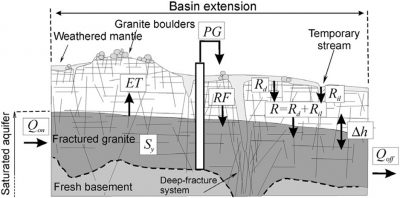An example of a method for managing water resources in basement aquifers in South India
PDFIndia, whose dominant climate is semi-arid, is the country that has most developed the resource of its basement aquifers. The number of water wells drilled for irrigation has increased from less than 1 million in the 1960s to more than 20 million today. This resource has thus made a major contribution to the country’s food self-sufficiency (the “green revolution”). This development has not been achieved without certain excesses (local overexploitation of the resource, degradation of groundwater quality) and their health and social consequences.

South India was one of the first regions to implement a method for assessing water resources in basement aquifers. It was based on a combination of the so-called “piezometric level fluctuations” method and the “groundwater budget” method. One of the objectives of this approach was to determine the unknowns of (annual) recharge and effective porosity of the aquifer.
The “groundwater budget” method therefore focuses on the different components of groundwater flows and stock variations, considering only the inputs and outputs of the aquifer (Figure 1). This method avoids uncertainties regarding rainfall and evapotranspiration in particular. However, it has the disadvantage of being carried out at the scale of the catchment area (the scale of the groundwater budget) and therefore not allowing an analysis at a finer scale than this one. The variations in the groundwater stock (ΔS), and therefore in the groundwater level Δh (h = piezometric level), can thus be attributed, with regard to the “inputs”, to recharge (R, sum of direct recharge through the unsaturated zone Rd and indirect and localized recharge from the surface waters Ril), to groundwater inputs at the boundaries of the groundwater catchment area (Qon ; These are normally zero if the catchment area has been well delineated) and, in the case of a study of a very agricultural catchment area, to the additional recharge due to excess irrigation (RF). For “exits”, these are groundwater exits at the boundaries of the groundwater catchment area (Qoff; with the same remark as for inputs), groundwater exits to streams or springs (Qbf), direct evapotranspiration from the groundwater (ET) and anthropogenic pumping (PG). Often, given the depth of the slick (several metres to several tens of metres), evapotranspiration is very low and this last term can be neglected.

ΔS = (R + RF + Qon) – (ET + PG + Qoff + Qbf) (1)
The second available equation links the fluctuations of the piezometric level Δh to those of the storage in the aquifer ΔS, via the storage coefficient, or effective porosity, of the Sy aquifer.
ΔS = Sy. Δh (2)
To calculate the R recharge and the Sy storage coefficient, we use the fact that, during the dry season, the decrease in the piezometric level is due solely to pumping. On the other hand, during the rainy season, the rise in the piezometric level is only due to the recharge reduced by the pumping. By measuring variations in piezometric level and pumping, it is therefore possible to evaluate recharge and storage. Observations over several years provide a robust model and, in particular, evaluate variations in effective porosity with depth and the evolution of recharge as a function of precipitation regime (Figure 2 [1]).

Basement aquifers can now be assessed, developed and, above all, managed sustainably. They are ready to participate in the economic development of other continents (Africa, South America in particular), which can thus contribute to meeting the challenges of the 21st century (food needs of the world population, satisfaction of water and sanitation needs, economic and social development, etc.). For researchers and water resource managers, the aim is to use the Indian example to stimulate and support economic development by avoiding the pitfalls of an unsustainable model (overexploitation of the resource) and by preserving, or even restoring, groundwater quality.
References and notes
[1] Marshal, J.C., Dewandel, B., Ahmed, S., Galeazzi L., 2006. Combining the groundwater budget and water table fluctuation methods to estimate specific yield and natural recharge. Journal of Hydrology, 329, 1-2, 281-293
[2] Lachassagne, P., Dewandel, B., Wyns, R. (2014b). The conceptual model of weathered hard rock aquifers and its practical applications, in “Fractured Rock Hydrogeology”, N°20 International Association of Hydrogeologists Selected




